Report on Tendering and Contract Administration in Construction
VerifiedAdded on 2022/08/18
|10
|2737
|21
Report
AI Summary
This report provides a comprehensive overview of tendering processes and contract administration within the construction industry. It begins by outlining the purpose of tendering, the process of selecting a tender, and various types of tendering including open, selective, and negotiated tendering. The report details tender documentation, including technical drawings, specifications, and relevant reports like soil assessments and pre-construction information. It then delves into the legal issues associated with tendering, such as CDM regulations, the Planning Act, working height regulations, and asbestos control. The second part of the report focuses on the roles of the contract administrator, covering responsibilities like preparing and signing contracts, executing contracts, conducting site duties, managing interim payments, ensuring health and safety compliance, and overseeing completion, defects, and final accounts. The report also discusses dispute resolution methods, including negotiation, mediation, arbitration, adjudication, and legal proceedings. The content is supported by references to key texts on construction contracts and legal frameworks.
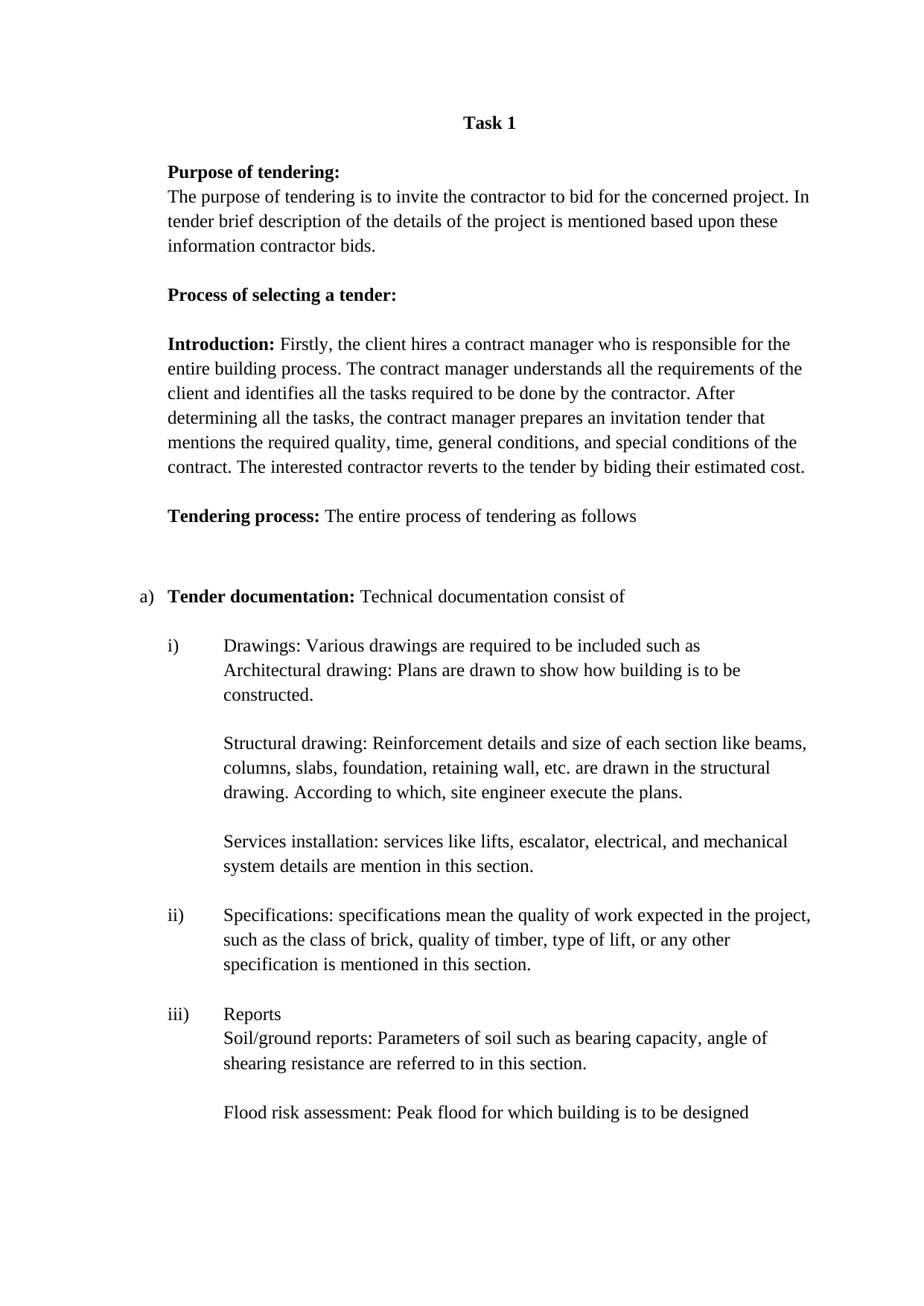
Task 1
Purpose of tendering:
The purpose of tendering is to invite the contractor to bid for the concerned project. In
tender brief description of the details of the project is mentioned based upon these
information contractor bids.
Process of selecting a tender:
Introduction: Firstly, the client hires a contract manager who is responsible for the
entire building process. The contract manager understands all the requirements of the
client and identifies all the tasks required to be done by the contractor. After
determining all the tasks, the contract manager prepares an invitation tender that
mentions the required quality, time, general conditions, and special conditions of the
contract. The interested contractor reverts to the tender by biding their estimated cost.
Tendering process: The entire process of tendering as follows
a) Tender documentation: Technical documentation consist of
i) Drawings: Various drawings are required to be included such as
Architectural drawing: Plans are drawn to show how building is to be
constructed.
Structural drawing: Reinforcement details and size of each section like beams,
columns, slabs, foundation, retaining wall, etc. are drawn in the structural
drawing. According to which, site engineer execute the plans.
Services installation: services like lifts, escalator, electrical, and mechanical
system details are mention in this section.
ii) Specifications: specifications mean the quality of work expected in the project,
such as the class of brick, quality of timber, type of lift, or any other
specification is mentioned in this section.
iii) Reports
Soil/ground reports: Parameters of soil such as bearing capacity, angle of
shearing resistance are referred to in this section.
Flood risk assessment: Peak flood for which building is to be designed
Purpose of tendering:
The purpose of tendering is to invite the contractor to bid for the concerned project. In
tender brief description of the details of the project is mentioned based upon these
information contractor bids.
Process of selecting a tender:
Introduction: Firstly, the client hires a contract manager who is responsible for the
entire building process. The contract manager understands all the requirements of the
client and identifies all the tasks required to be done by the contractor. After
determining all the tasks, the contract manager prepares an invitation tender that
mentions the required quality, time, general conditions, and special conditions of the
contract. The interested contractor reverts to the tender by biding their estimated cost.
Tendering process: The entire process of tendering as follows
a) Tender documentation: Technical documentation consist of
i) Drawings: Various drawings are required to be included such as
Architectural drawing: Plans are drawn to show how building is to be
constructed.
Structural drawing: Reinforcement details and size of each section like beams,
columns, slabs, foundation, retaining wall, etc. are drawn in the structural
drawing. According to which, site engineer execute the plans.
Services installation: services like lifts, escalator, electrical, and mechanical
system details are mention in this section.
ii) Specifications: specifications mean the quality of work expected in the project,
such as the class of brick, quality of timber, type of lift, or any other
specification is mentioned in this section.
iii) Reports
Soil/ground reports: Parameters of soil such as bearing capacity, angle of
shearing resistance are referred to in this section.
Flood risk assessment: Peak flood for which building is to be designed
Paraphrase This Document
Need a fresh take? Get an instant paraphrase of this document with our AI Paraphraser
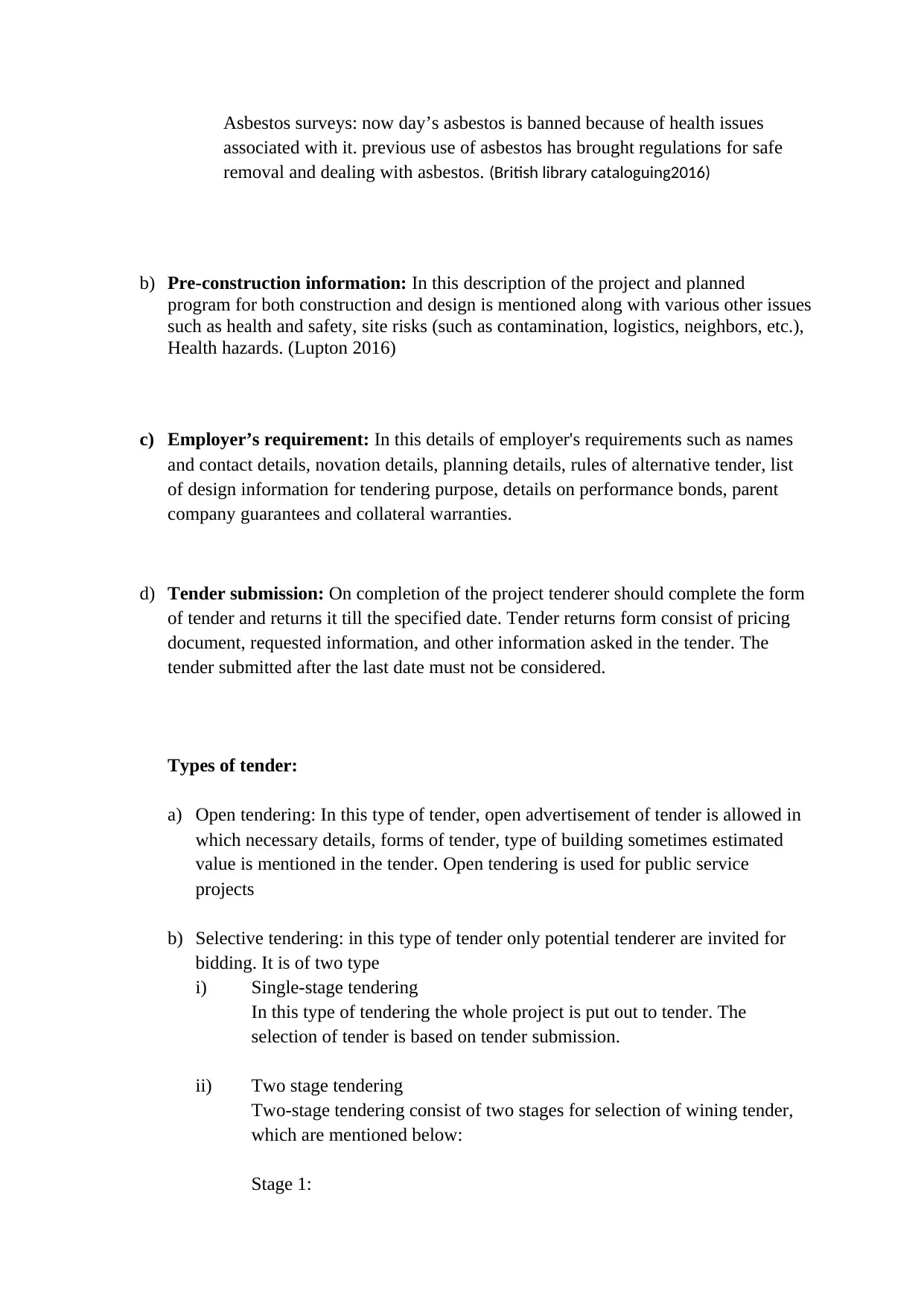
Asbestos surveys: now day’s asbestos is banned because of health issues
associated with it. previous use of asbestos has brought regulations for safe
removal and dealing with asbestos. (British library cataloguing2016)
b) Pre-construction information: In this description of the project and planned
program for both construction and design is mentioned along with various other issues
such as health and safety, site risks (such as contamination, logistics, neighbors, etc.),
Health hazards. (Lupton 2016)
c) Employer’s requirement: In this details of employer's requirements such as names
and contact details, novation details, planning details, rules of alternative tender, list
of design information for tendering purpose, details on performance bonds, parent
company guarantees and collateral warranties.
d) Tender submission: On completion of the project tenderer should complete the form
of tender and returns it till the specified date. Tender returns form consist of pricing
document, requested information, and other information asked in the tender. The
tender submitted after the last date must not be considered.
Types of tender:
a) Open tendering: In this type of tender, open advertisement of tender is allowed in
which necessary details, forms of tender, type of building sometimes estimated
value is mentioned in the tender. Open tendering is used for public service
projects
b) Selective tendering: in this type of tender only potential tenderer are invited for
bidding. It is of two type
i) Single-stage tendering
In this type of tendering the whole project is put out to tender. The
selection of tender is based on tender submission.
ii) Two stage tendering
Two-stage tendering consist of two stages for selection of wining tender,
which are mentioned below:
Stage 1:
associated with it. previous use of asbestos has brought regulations for safe
removal and dealing with asbestos. (British library cataloguing2016)
b) Pre-construction information: In this description of the project and planned
program for both construction and design is mentioned along with various other issues
such as health and safety, site risks (such as contamination, logistics, neighbors, etc.),
Health hazards. (Lupton 2016)
c) Employer’s requirement: In this details of employer's requirements such as names
and contact details, novation details, planning details, rules of alternative tender, list
of design information for tendering purpose, details on performance bonds, parent
company guarantees and collateral warranties.
d) Tender submission: On completion of the project tenderer should complete the form
of tender and returns it till the specified date. Tender returns form consist of pricing
document, requested information, and other information asked in the tender. The
tender submitted after the last date must not be considered.
Types of tender:
a) Open tendering: In this type of tender, open advertisement of tender is allowed in
which necessary details, forms of tender, type of building sometimes estimated
value is mentioned in the tender. Open tendering is used for public service
projects
b) Selective tendering: in this type of tender only potential tenderer are invited for
bidding. It is of two type
i) Single-stage tendering
In this type of tendering the whole project is put out to tender. The
selection of tender is based on tender submission.
ii) Two stage tendering
Two-stage tendering consist of two stages for selection of wining tender,
which are mentioned below:
Stage 1:
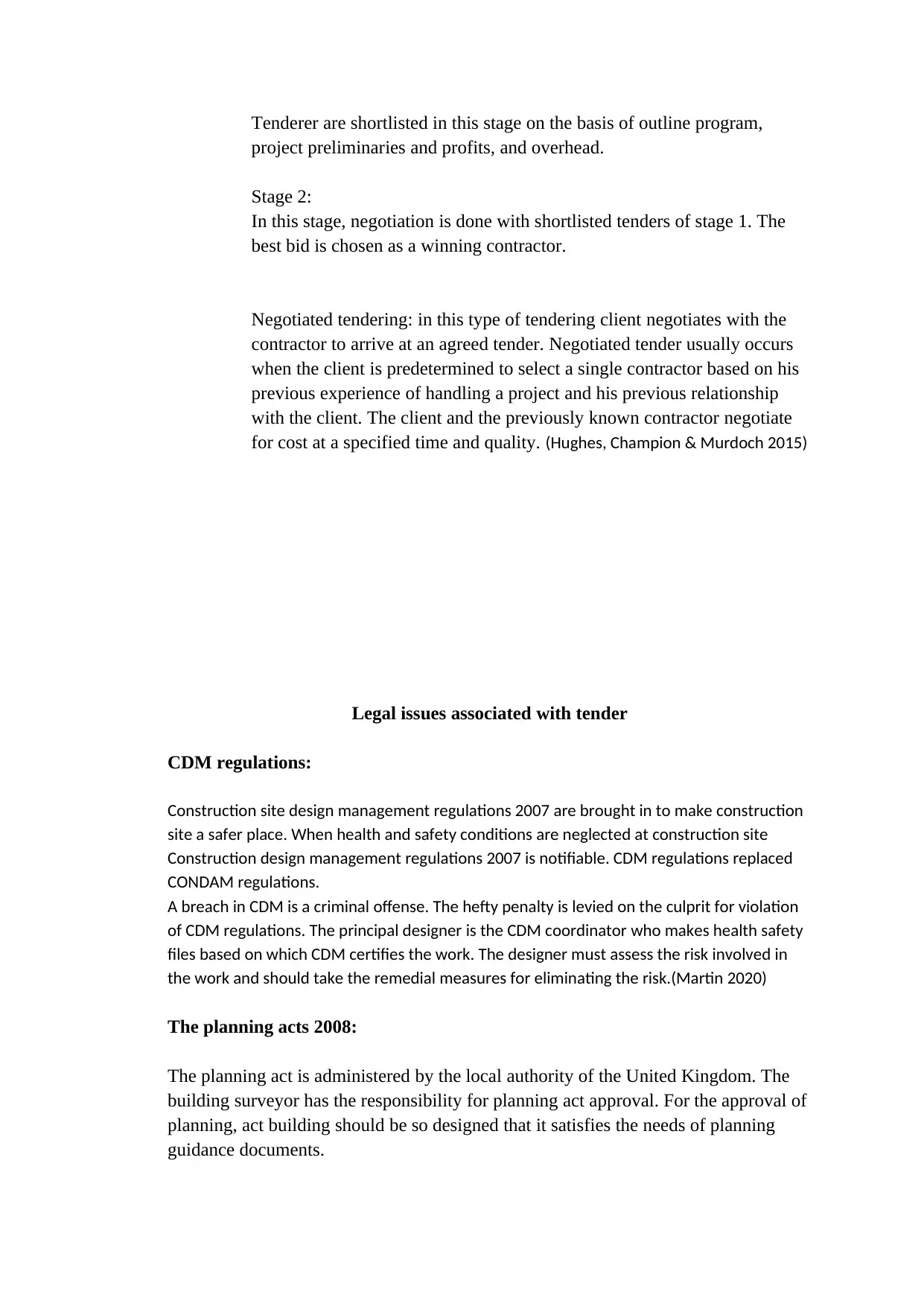
Tenderer are shortlisted in this stage on the basis of outline program,
project preliminaries and profits, and overhead.
Stage 2:
In this stage, negotiation is done with shortlisted tenders of stage 1. The
best bid is chosen as a winning contractor.
Negotiated tendering: in this type of tendering client negotiates with the
contractor to arrive at an agreed tender. Negotiated tender usually occurs
when the client is predetermined to select a single contractor based on his
previous experience of handling a project and his previous relationship
with the client. The client and the previously known contractor negotiate
for cost at a specified time and quality. (Hughes, Champion & Murdoch 2015)
Legal issues associated with tender
CDM regulations:
Construction site design management regulations 2007 are brought in to make construction
site a safer place. When health and safety conditions are neglected at construction site
Construction design management regulations 2007 is notifiable. CDM regulations replaced
CONDAM regulations.
A breach in CDM is a criminal offense. The hefty penalty is levied on the culprit for violation
of CDM regulations. The principal designer is the CDM coordinator who makes health safety
files based on which CDM certifies the work. The designer must assess the risk involved in
the work and should take the remedial measures for eliminating the risk.(Martin 2020)
The planning acts 2008:
The planning act is administered by the local authority of the United Kingdom. The
building surveyor has the responsibility for planning act approval. For the approval of
planning, act building should be so designed that it satisfies the needs of planning
guidance documents.
project preliminaries and profits, and overhead.
Stage 2:
In this stage, negotiation is done with shortlisted tenders of stage 1. The
best bid is chosen as a winning contractor.
Negotiated tendering: in this type of tendering client negotiates with the
contractor to arrive at an agreed tender. Negotiated tender usually occurs
when the client is predetermined to select a single contractor based on his
previous experience of handling a project and his previous relationship
with the client. The client and the previously known contractor negotiate
for cost at a specified time and quality. (Hughes, Champion & Murdoch 2015)
Legal issues associated with tender
CDM regulations:
Construction site design management regulations 2007 are brought in to make construction
site a safer place. When health and safety conditions are neglected at construction site
Construction design management regulations 2007 is notifiable. CDM regulations replaced
CONDAM regulations.
A breach in CDM is a criminal offense. The hefty penalty is levied on the culprit for violation
of CDM regulations. The principal designer is the CDM coordinator who makes health safety
files based on which CDM certifies the work. The designer must assess the risk involved in
the work and should take the remedial measures for eliminating the risk.(Martin 2020)
The planning acts 2008:
The planning act is administered by the local authority of the United Kingdom. The
building surveyor has the responsibility for planning act approval. For the approval of
planning, act building should be so designed that it satisfies the needs of planning
guidance documents.
⊘ This is a preview!⊘
Do you want full access?
Subscribe today to unlock all pages.

Trusted by 1+ million students worldwide
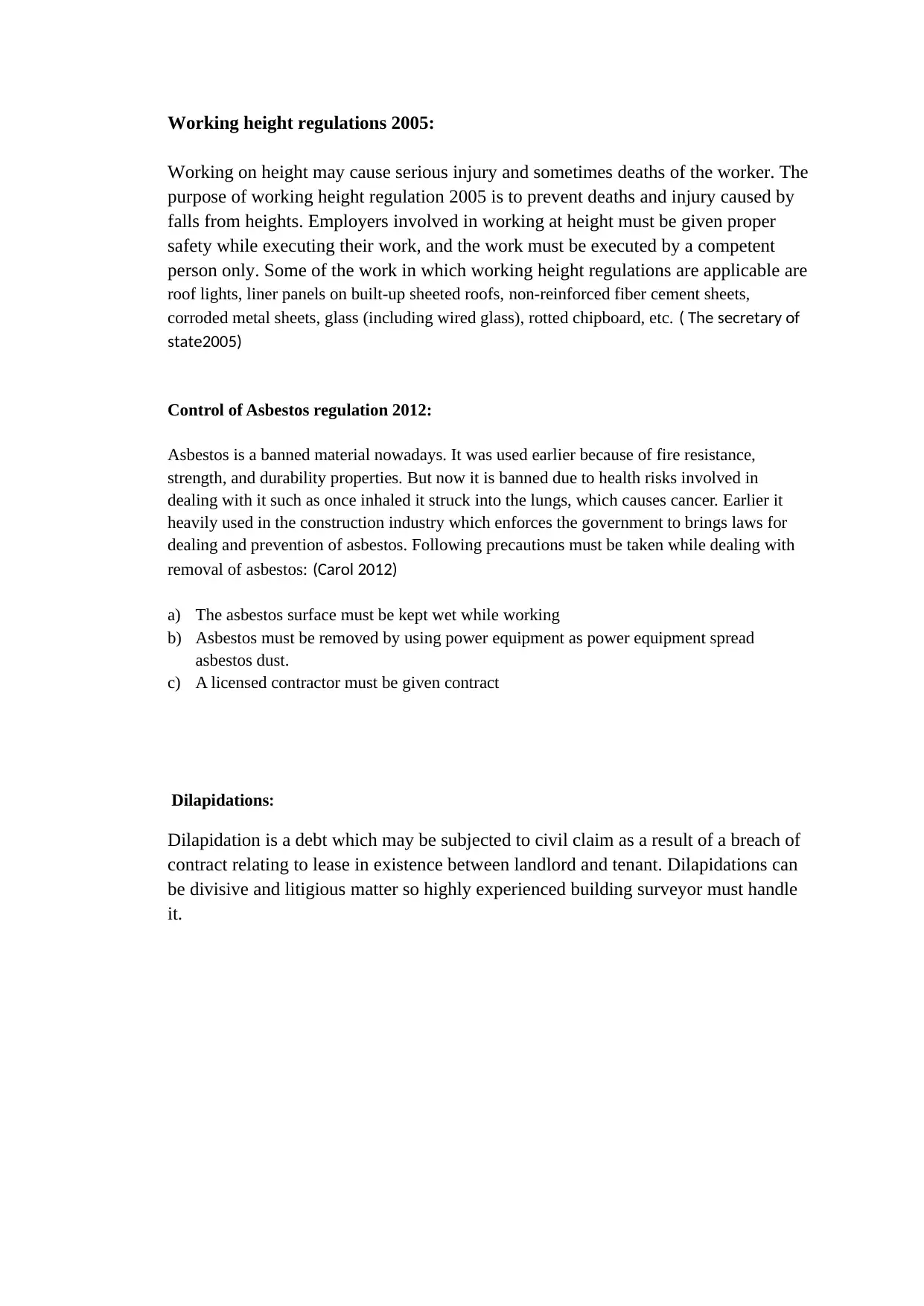
Working height regulations 2005:
Working on height may cause serious injury and sometimes deaths of the worker. The
purpose of working height regulation 2005 is to prevent deaths and injury caused by
falls from heights. Employers involved in working at height must be given proper
safety while executing their work, and the work must be executed by a competent
person only. Some of the work in which working height regulations are applicable are
roof lights, liner panels on built-up sheeted roofs, non-reinforced fiber cement sheets,
corroded metal sheets, glass (including wired glass), rotted chipboard, etc. ( The secretary of
state2005)
Control of Asbestos regulation 2012:
Asbestos is a banned material nowadays. It was used earlier because of fire resistance,
strength, and durability properties. But now it is banned due to health risks involved in
dealing with it such as once inhaled it struck into the lungs, which causes cancer. Earlier it
heavily used in the construction industry which enforces the government to brings laws for
dealing and prevention of asbestos. Following precautions must be taken while dealing with
removal of asbestos: (Carol 2012)
a) The asbestos surface must be kept wet while working
b) Asbestos must be removed by using power equipment as power equipment spread
asbestos dust.
c) A licensed contractor must be given contract
Dilapidations:
Dilapidation is a debt which may be subjected to civil claim as a result of a breach of
contract relating to lease in existence between landlord and tenant. Dilapidations can
be divisive and litigious matter so highly experienced building surveyor must handle
it.
Working on height may cause serious injury and sometimes deaths of the worker. The
purpose of working height regulation 2005 is to prevent deaths and injury caused by
falls from heights. Employers involved in working at height must be given proper
safety while executing their work, and the work must be executed by a competent
person only. Some of the work in which working height regulations are applicable are
roof lights, liner panels on built-up sheeted roofs, non-reinforced fiber cement sheets,
corroded metal sheets, glass (including wired glass), rotted chipboard, etc. ( The secretary of
state2005)
Control of Asbestos regulation 2012:
Asbestos is a banned material nowadays. It was used earlier because of fire resistance,
strength, and durability properties. But now it is banned due to health risks involved in
dealing with it such as once inhaled it struck into the lungs, which causes cancer. Earlier it
heavily used in the construction industry which enforces the government to brings laws for
dealing and prevention of asbestos. Following precautions must be taken while dealing with
removal of asbestos: (Carol 2012)
a) The asbestos surface must be kept wet while working
b) Asbestos must be removed by using power equipment as power equipment spread
asbestos dust.
c) A licensed contractor must be given contract
Dilapidations:
Dilapidation is a debt which may be subjected to civil claim as a result of a breach of
contract relating to lease in existence between landlord and tenant. Dilapidations can
be divisive and litigious matter so highly experienced building surveyor must handle
it.
Paraphrase This Document
Need a fresh take? Get an instant paraphrase of this document with our AI Paraphraser
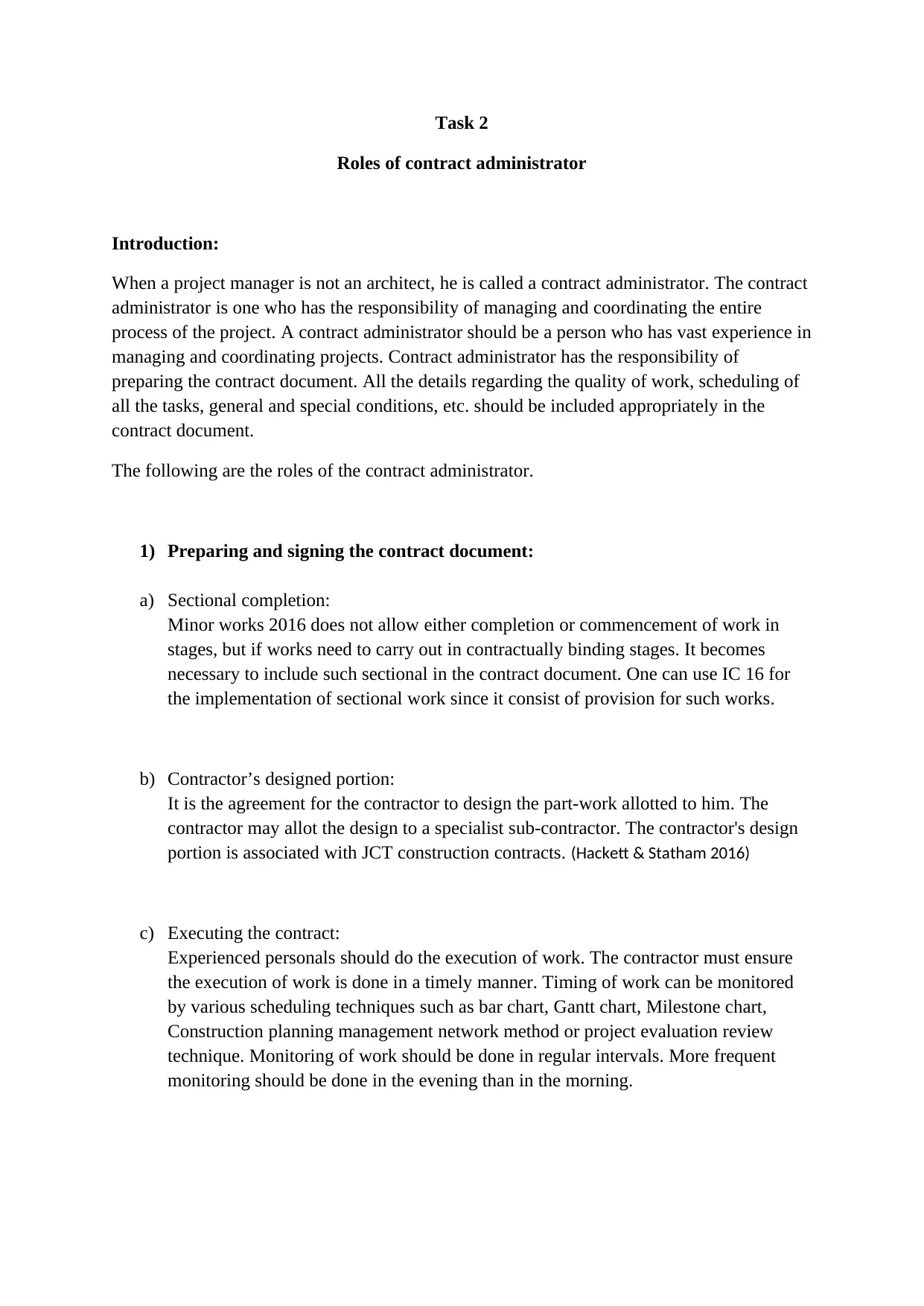
Task 2
Roles of contract administrator
Introduction:
When a project manager is not an architect, he is called a contract administrator. The contract
administrator is one who has the responsibility of managing and coordinating the entire
process of the project. A contract administrator should be a person who has vast experience in
managing and coordinating projects. Contract administrator has the responsibility of
preparing the contract document. All the details regarding the quality of work, scheduling of
all the tasks, general and special conditions, etc. should be included appropriately in the
contract document.
The following are the roles of the contract administrator.
1) Preparing and signing the contract document:
a) Sectional completion:
Minor works 2016 does not allow either completion or commencement of work in
stages, but if works need to carry out in contractually binding stages. It becomes
necessary to include such sectional in the contract document. One can use IC 16 for
the implementation of sectional work since it consist of provision for such works.
b) Contractor’s designed portion:
It is the agreement for the contractor to design the part-work allotted to him. The
contractor may allot the design to a specialist sub-contractor. The contractor's design
portion is associated with JCT construction contracts. (Hackett & Statham 2016)
c) Executing the contract:
Experienced personals should do the execution of work. The contractor must ensure
the execution of work is done in a timely manner. Timing of work can be monitored
by various scheduling techniques such as bar chart, Gantt chart, Milestone chart,
Construction planning management network method or project evaluation review
technique. Monitoring of work should be done in regular intervals. More frequent
monitoring should be done in the evening than in the morning.
Roles of contract administrator
Introduction:
When a project manager is not an architect, he is called a contract administrator. The contract
administrator is one who has the responsibility of managing and coordinating the entire
process of the project. A contract administrator should be a person who has vast experience in
managing and coordinating projects. Contract administrator has the responsibility of
preparing the contract document. All the details regarding the quality of work, scheduling of
all the tasks, general and special conditions, etc. should be included appropriately in the
contract document.
The following are the roles of the contract administrator.
1) Preparing and signing the contract document:
a) Sectional completion:
Minor works 2016 does not allow either completion or commencement of work in
stages, but if works need to carry out in contractually binding stages. It becomes
necessary to include such sectional in the contract document. One can use IC 16 for
the implementation of sectional work since it consist of provision for such works.
b) Contractor’s designed portion:
It is the agreement for the contractor to design the part-work allotted to him. The
contractor may allot the design to a specialist sub-contractor. The contractor's design
portion is associated with JCT construction contracts. (Hackett & Statham 2016)
c) Executing the contract:
Experienced personals should do the execution of work. The contractor must ensure
the execution of work is done in a timely manner. Timing of work can be monitored
by various scheduling techniques such as bar chart, Gantt chart, Milestone chart,
Construction planning management network method or project evaluation review
technique. Monitoring of work should be done in regular intervals. More frequent
monitoring should be done in the evening than in the morning.
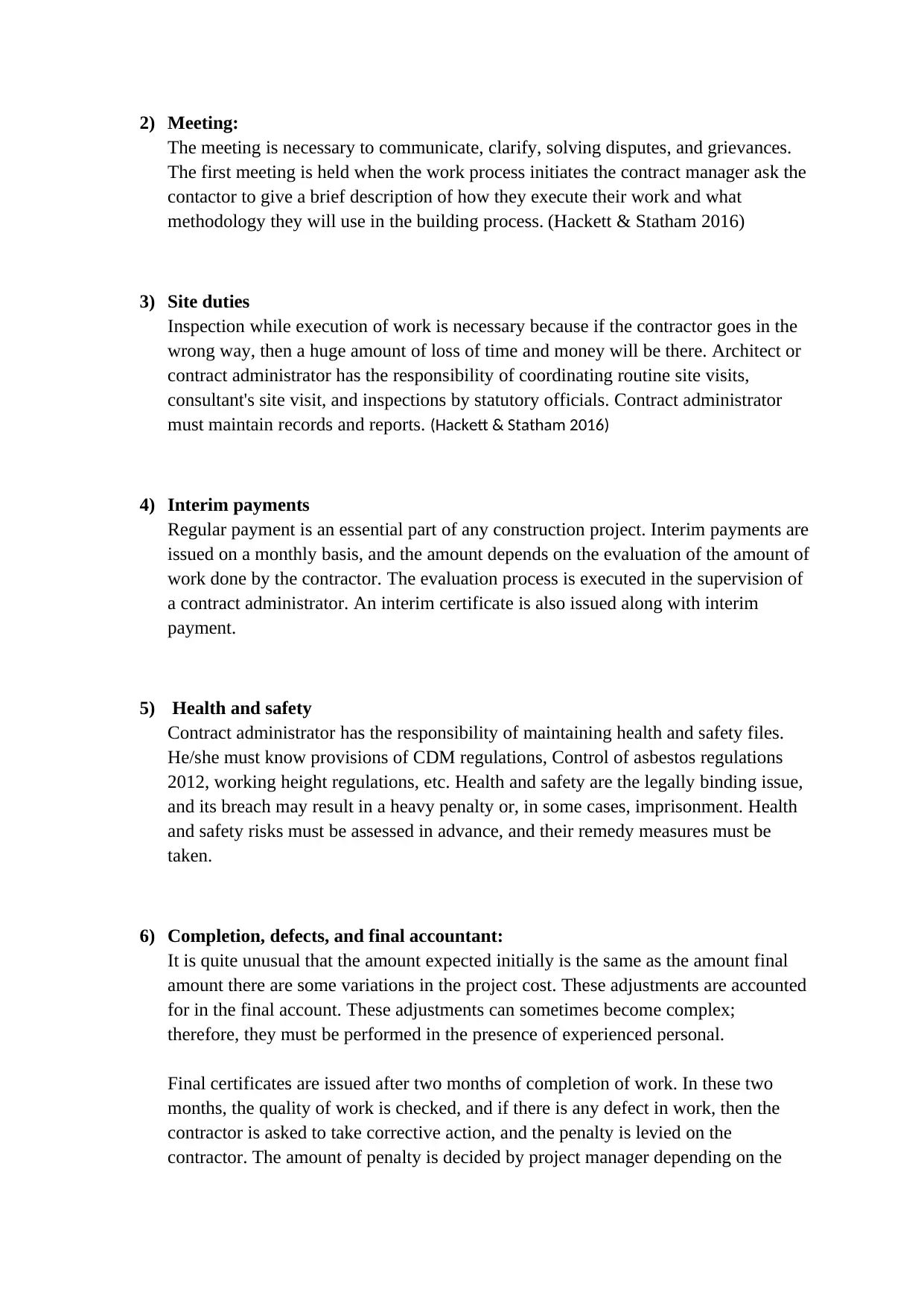
2) Meeting:
The meeting is necessary to communicate, clarify, solving disputes, and grievances.
The first meeting is held when the work process initiates the contract manager ask the
contactor to give a brief description of how they execute their work and what
methodology they will use in the building process. (Hackett & Statham 2016)
3) Site duties
Inspection while execution of work is necessary because if the contractor goes in the
wrong way, then a huge amount of loss of time and money will be there. Architect or
contract administrator has the responsibility of coordinating routine site visits,
consultant's site visit, and inspections by statutory officials. Contract administrator
must maintain records and reports. (Hackett & Statham 2016)
4) Interim payments
Regular payment is an essential part of any construction project. Interim payments are
issued on a monthly basis, and the amount depends on the evaluation of the amount of
work done by the contractor. The evaluation process is executed in the supervision of
a contract administrator. An interim certificate is also issued along with interim
payment.
5) Health and safety
Contract administrator has the responsibility of maintaining health and safety files.
He/she must know provisions of CDM regulations, Control of asbestos regulations
2012, working height regulations, etc. Health and safety are the legally binding issue,
and its breach may result in a heavy penalty or, in some cases, imprisonment. Health
and safety risks must be assessed in advance, and their remedy measures must be
taken.
6) Completion, defects, and final accountant:
It is quite unusual that the amount expected initially is the same as the amount final
amount there are some variations in the project cost. These adjustments are accounted
for in the final account. These adjustments can sometimes become complex;
therefore, they must be performed in the presence of experienced personal.
Final certificates are issued after two months of completion of work. In these two
months, the quality of work is checked, and if there is any defect in work, then the
contractor is asked to take corrective action, and the penalty is levied on the
contractor. The amount of penalty is decided by project manager depending on the
The meeting is necessary to communicate, clarify, solving disputes, and grievances.
The first meeting is held when the work process initiates the contract manager ask the
contactor to give a brief description of how they execute their work and what
methodology they will use in the building process. (Hackett & Statham 2016)
3) Site duties
Inspection while execution of work is necessary because if the contractor goes in the
wrong way, then a huge amount of loss of time and money will be there. Architect or
contract administrator has the responsibility of coordinating routine site visits,
consultant's site visit, and inspections by statutory officials. Contract administrator
must maintain records and reports. (Hackett & Statham 2016)
4) Interim payments
Regular payment is an essential part of any construction project. Interim payments are
issued on a monthly basis, and the amount depends on the evaluation of the amount of
work done by the contractor. The evaluation process is executed in the supervision of
a contract administrator. An interim certificate is also issued along with interim
payment.
5) Health and safety
Contract administrator has the responsibility of maintaining health and safety files.
He/she must know provisions of CDM regulations, Control of asbestos regulations
2012, working height regulations, etc. Health and safety are the legally binding issue,
and its breach may result in a heavy penalty or, in some cases, imprisonment. Health
and safety risks must be assessed in advance, and their remedy measures must be
taken.
6) Completion, defects, and final accountant:
It is quite unusual that the amount expected initially is the same as the amount final
amount there are some variations in the project cost. These adjustments are accounted
for in the final account. These adjustments can sometimes become complex;
therefore, they must be performed in the presence of experienced personal.
Final certificates are issued after two months of completion of work. In these two
months, the quality of work is checked, and if there is any defect in work, then the
contractor is asked to take corrective action, and the penalty is levied on the
contractor. The amount of penalty is decided by project manager depending on the
⊘ This is a preview!⊘
Do you want full access?
Subscribe today to unlock all pages.

Trusted by 1+ million students worldwide
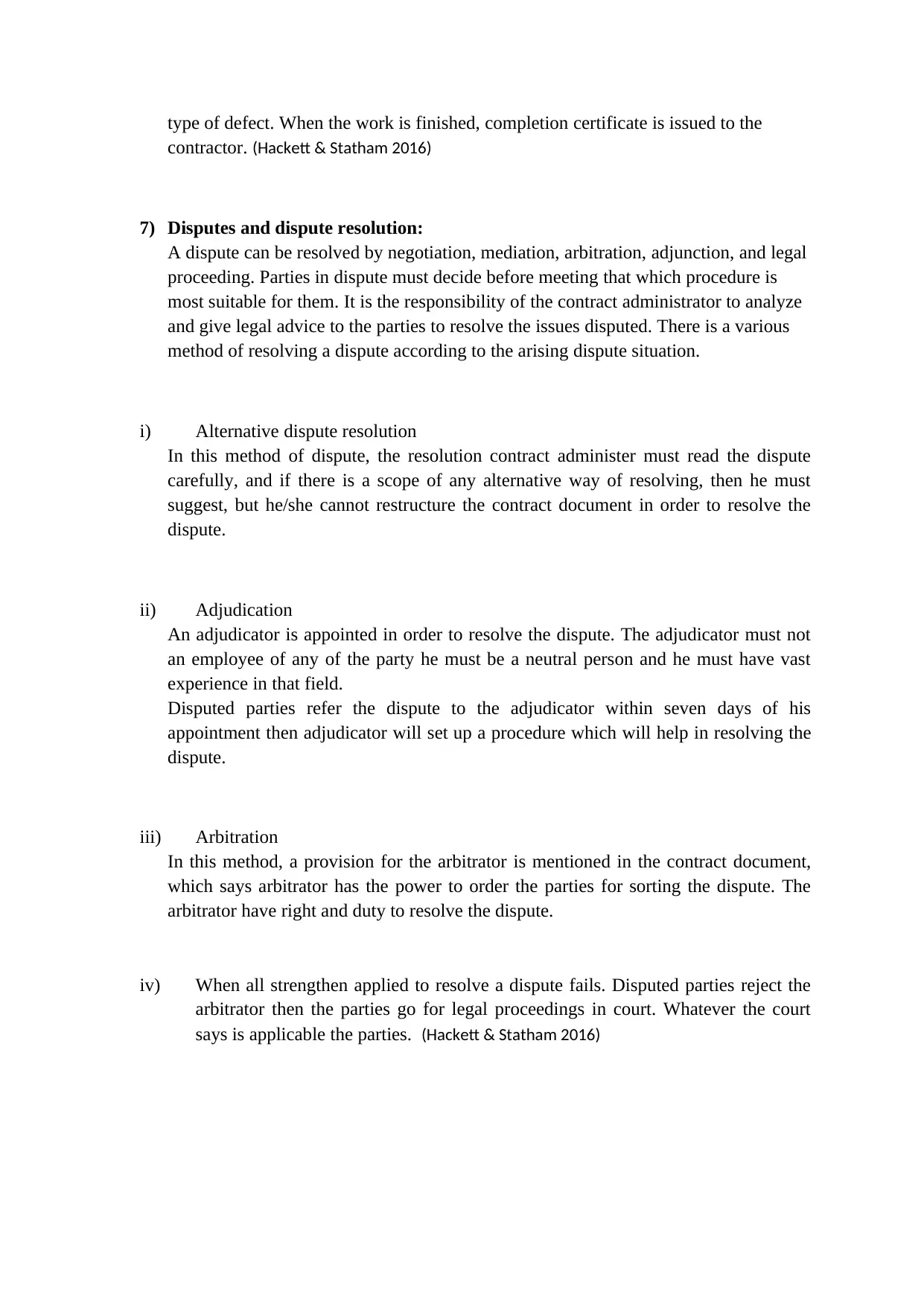
type of defect. When the work is finished, completion certificate is issued to the
contractor. (Hackett & Statham 2016)
7) Disputes and dispute resolution:
A dispute can be resolved by negotiation, mediation, arbitration, adjunction, and legal
proceeding. Parties in dispute must decide before meeting that which procedure is
most suitable for them. It is the responsibility of the contract administrator to analyze
and give legal advice to the parties to resolve the issues disputed. There is a various
method of resolving a dispute according to the arising dispute situation.
i) Alternative dispute resolution
In this method of dispute, the resolution contract administer must read the dispute
carefully, and if there is a scope of any alternative way of resolving, then he must
suggest, but he/she cannot restructure the contract document in order to resolve the
dispute.
ii) Adjudication
An adjudicator is appointed in order to resolve the dispute. The adjudicator must not
an employee of any of the party he must be a neutral person and he must have vast
experience in that field.
Disputed parties refer the dispute to the adjudicator within seven days of his
appointment then adjudicator will set up a procedure which will help in resolving the
dispute.
iii) Arbitration
In this method, a provision for the arbitrator is mentioned in the contract document,
which says arbitrator has the power to order the parties for sorting the dispute. The
arbitrator have right and duty to resolve the dispute.
iv) When all strengthen applied to resolve a dispute fails. Disputed parties reject the
arbitrator then the parties go for legal proceedings in court. Whatever the court
says is applicable the parties. (Hackett & Statham 2016)
contractor. (Hackett & Statham 2016)
7) Disputes and dispute resolution:
A dispute can be resolved by negotiation, mediation, arbitration, adjunction, and legal
proceeding. Parties in dispute must decide before meeting that which procedure is
most suitable for them. It is the responsibility of the contract administrator to analyze
and give legal advice to the parties to resolve the issues disputed. There is a various
method of resolving a dispute according to the arising dispute situation.
i) Alternative dispute resolution
In this method of dispute, the resolution contract administer must read the dispute
carefully, and if there is a scope of any alternative way of resolving, then he must
suggest, but he/she cannot restructure the contract document in order to resolve the
dispute.
ii) Adjudication
An adjudicator is appointed in order to resolve the dispute. The adjudicator must not
an employee of any of the party he must be a neutral person and he must have vast
experience in that field.
Disputed parties refer the dispute to the adjudicator within seven days of his
appointment then adjudicator will set up a procedure which will help in resolving the
dispute.
iii) Arbitration
In this method, a provision for the arbitrator is mentioned in the contract document,
which says arbitrator has the power to order the parties for sorting the dispute. The
arbitrator have right and duty to resolve the dispute.
iv) When all strengthen applied to resolve a dispute fails. Disputed parties reject the
arbitrator then the parties go for legal proceedings in court. Whatever the court
says is applicable the parties. (Hackett & Statham 2016)
Paraphrase This Document
Need a fresh take? Get an instant paraphrase of this document with our AI Paraphraser

References
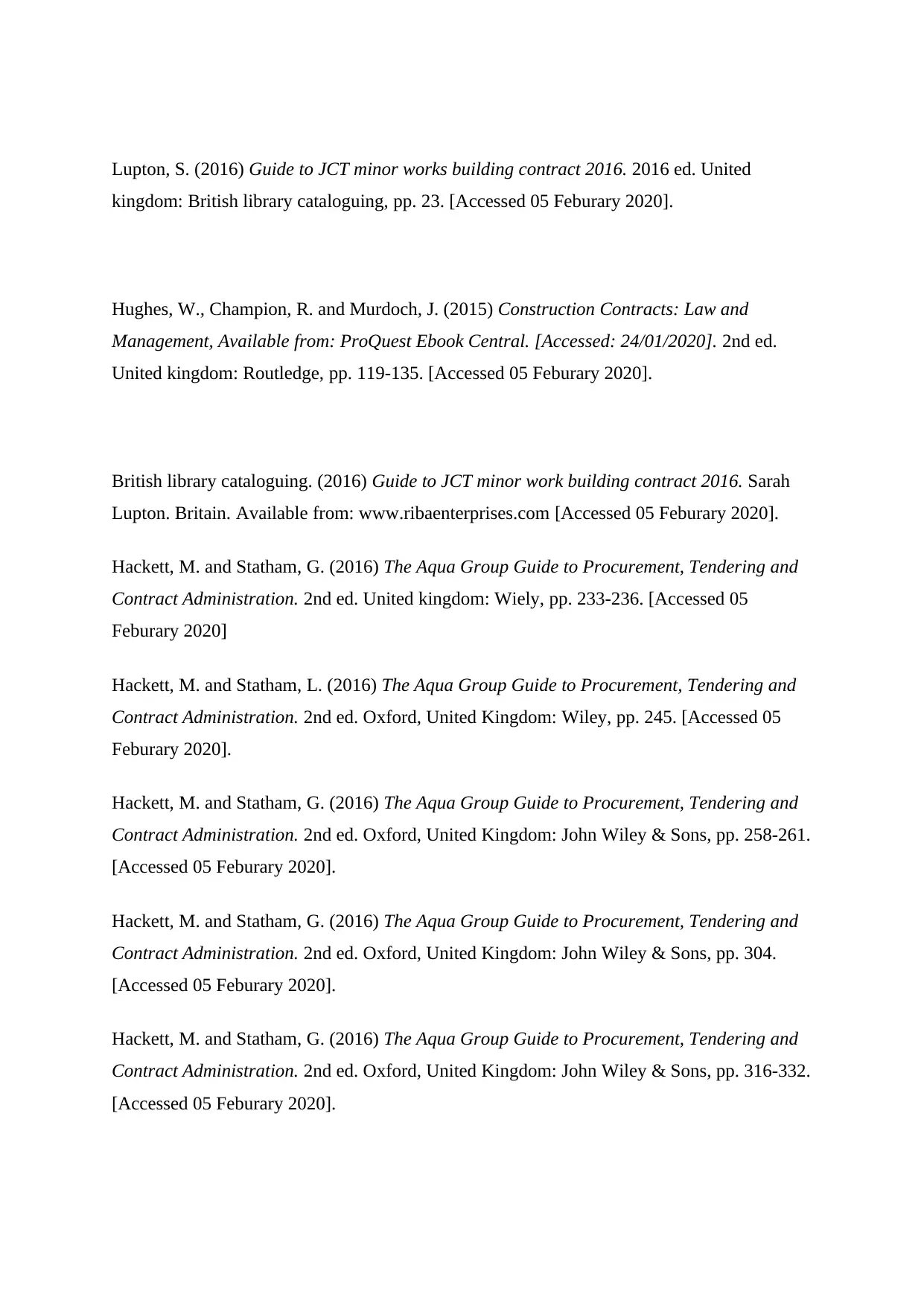
Lupton, S. (2016) Guide to JCT minor works building contract 2016. 2016 ed. United
kingdom: British library cataloguing, pp. 23. [Accessed 05 Feburary 2020].
Hughes, W., Champion, R. and Murdoch, J. (2015) Construction Contracts: Law and
Management, Available from: ProQuest Ebook Central. [Accessed: 24/01/2020]. 2nd ed.
United kingdom: Routledge, pp. 119-135. [Accessed 05 Feburary 2020].
British library cataloguing. (2016) Guide to JCT minor work building contract 2016. Sarah
Lupton. Britain. Available from: www.ribaenterprises.com [Accessed 05 Feburary 2020].
Hackett, M. and Statham, G. (2016) The Aqua Group Guide to Procurement, Tendering and
Contract Administration. 2nd ed. United kingdom: Wiely, pp. 233-236. [Accessed 05
Feburary 2020]
Hackett, M. and Statham, L. (2016) The Aqua Group Guide to Procurement, Tendering and
Contract Administration. 2nd ed. Oxford, United Kingdom: Wiley, pp. 245. [Accessed 05
Feburary 2020].
Hackett, M. and Statham, G. (2016) The Aqua Group Guide to Procurement, Tendering and
Contract Administration. 2nd ed. Oxford, United Kingdom: John Wiley & Sons, pp. 258-261.
[Accessed 05 Feburary 2020].
Hackett, M. and Statham, G. (2016) The Aqua Group Guide to Procurement, Tendering and
Contract Administration. 2nd ed. Oxford, United Kingdom: John Wiley & Sons, pp. 304.
[Accessed 05 Feburary 2020].
Hackett, M. and Statham, G. (2016) The Aqua Group Guide to Procurement, Tendering and
Contract Administration. 2nd ed. Oxford, United Kingdom: John Wiley & Sons, pp. 316-332.
[Accessed 05 Feburary 2020].
kingdom: British library cataloguing, pp. 23. [Accessed 05 Feburary 2020].
Hughes, W., Champion, R. and Murdoch, J. (2015) Construction Contracts: Law and
Management, Available from: ProQuest Ebook Central. [Accessed: 24/01/2020]. 2nd ed.
United kingdom: Routledge, pp. 119-135. [Accessed 05 Feburary 2020].
British library cataloguing. (2016) Guide to JCT minor work building contract 2016. Sarah
Lupton. Britain. Available from: www.ribaenterprises.com [Accessed 05 Feburary 2020].
Hackett, M. and Statham, G. (2016) The Aqua Group Guide to Procurement, Tendering and
Contract Administration. 2nd ed. United kingdom: Wiely, pp. 233-236. [Accessed 05
Feburary 2020]
Hackett, M. and Statham, L. (2016) The Aqua Group Guide to Procurement, Tendering and
Contract Administration. 2nd ed. Oxford, United Kingdom: Wiley, pp. 245. [Accessed 05
Feburary 2020].
Hackett, M. and Statham, G. (2016) The Aqua Group Guide to Procurement, Tendering and
Contract Administration. 2nd ed. Oxford, United Kingdom: John Wiley & Sons, pp. 258-261.
[Accessed 05 Feburary 2020].
Hackett, M. and Statham, G. (2016) The Aqua Group Guide to Procurement, Tendering and
Contract Administration. 2nd ed. Oxford, United Kingdom: John Wiley & Sons, pp. 304.
[Accessed 05 Feburary 2020].
Hackett, M. and Statham, G. (2016) The Aqua Group Guide to Procurement, Tendering and
Contract Administration. 2nd ed. Oxford, United Kingdom: John Wiley & Sons, pp. 316-332.
[Accessed 05 Feburary 2020].
⊘ This is a preview!⊘
Do you want full access?
Subscribe today to unlock all pages.

Trusted by 1+ million students worldwide
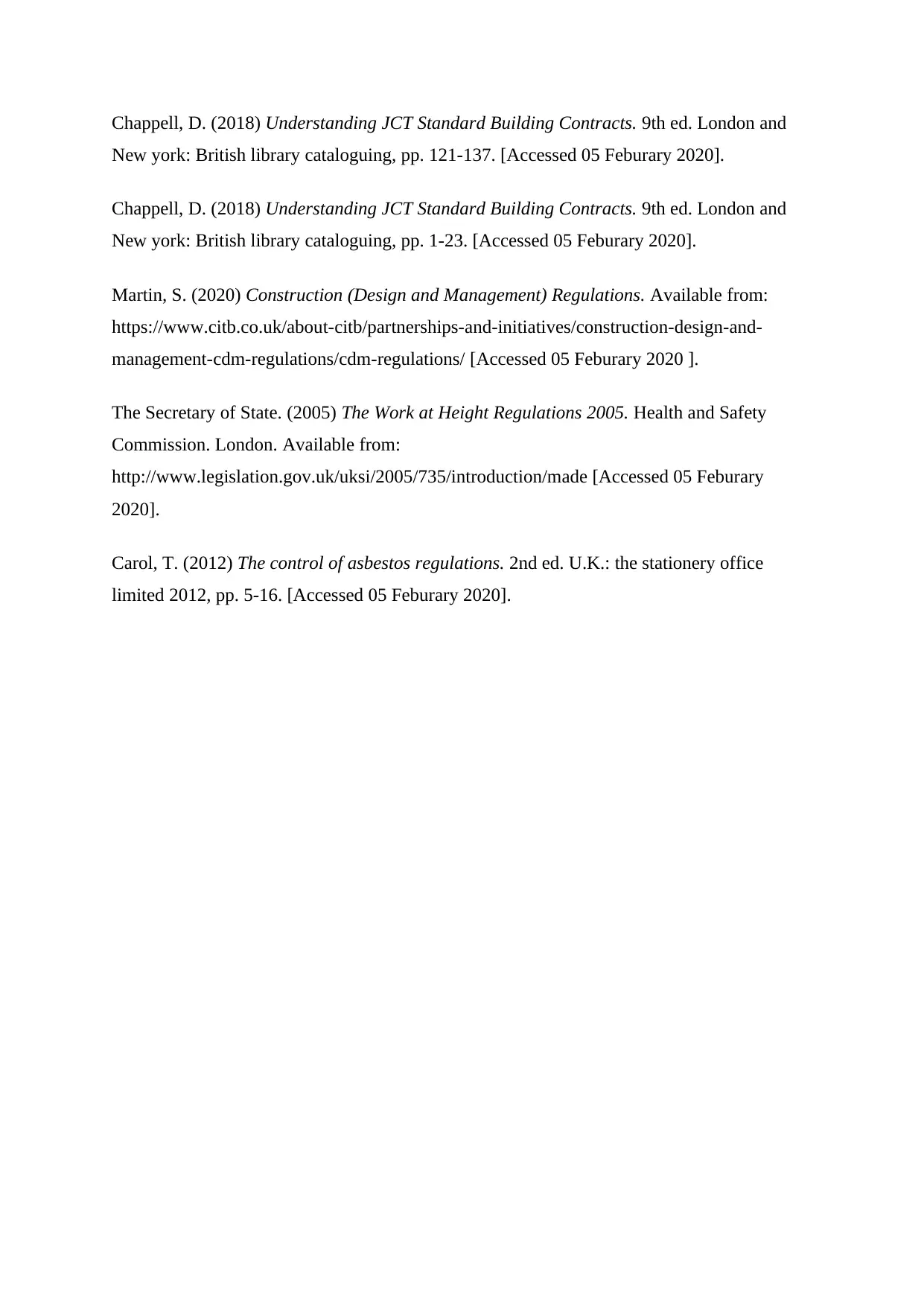
Chappell, D. (2018) Understanding JCT Standard Building Contracts. 9th ed. London and
New york: British library cataloguing, pp. 121-137. [Accessed 05 Feburary 2020].
Chappell, D. (2018) Understanding JCT Standard Building Contracts. 9th ed. London and
New york: British library cataloguing, pp. 1-23. [Accessed 05 Feburary 2020].
Martin, S. (2020) Construction (Design and Management) Regulations. Available from:
https://www.citb.co.uk/about-citb/partnerships-and-initiatives/construction-design-and-
management-cdm-regulations/cdm-regulations/ [Accessed 05 Feburary 2020 ].
The Secretary of State. (2005) The Work at Height Regulations 2005. Health and Safety
Commission. London. Available from:
http://www.legislation.gov.uk/uksi/2005/735/introduction/made [Accessed 05 Feburary
2020].
Carol, T. (2012) The control of asbestos regulations. 2nd ed. U.K.: the stationery office
limited 2012, pp. 5-16. [Accessed 05 Feburary 2020].
New york: British library cataloguing, pp. 121-137. [Accessed 05 Feburary 2020].
Chappell, D. (2018) Understanding JCT Standard Building Contracts. 9th ed. London and
New york: British library cataloguing, pp. 1-23. [Accessed 05 Feburary 2020].
Martin, S. (2020) Construction (Design and Management) Regulations. Available from:
https://www.citb.co.uk/about-citb/partnerships-and-initiatives/construction-design-and-
management-cdm-regulations/cdm-regulations/ [Accessed 05 Feburary 2020 ].
The Secretary of State. (2005) The Work at Height Regulations 2005. Health and Safety
Commission. London. Available from:
http://www.legislation.gov.uk/uksi/2005/735/introduction/made [Accessed 05 Feburary
2020].
Carol, T. (2012) The control of asbestos regulations. 2nd ed. U.K.: the stationery office
limited 2012, pp. 5-16. [Accessed 05 Feburary 2020].
1 out of 10
Related Documents
Your All-in-One AI-Powered Toolkit for Academic Success.
+13062052269
info@desklib.com
Available 24*7 on WhatsApp / Email
![[object Object]](/_next/static/media/star-bottom.7253800d.svg)
Unlock your academic potential
Copyright © 2020–2025 A2Z Services. All Rights Reserved. Developed and managed by ZUCOL.




